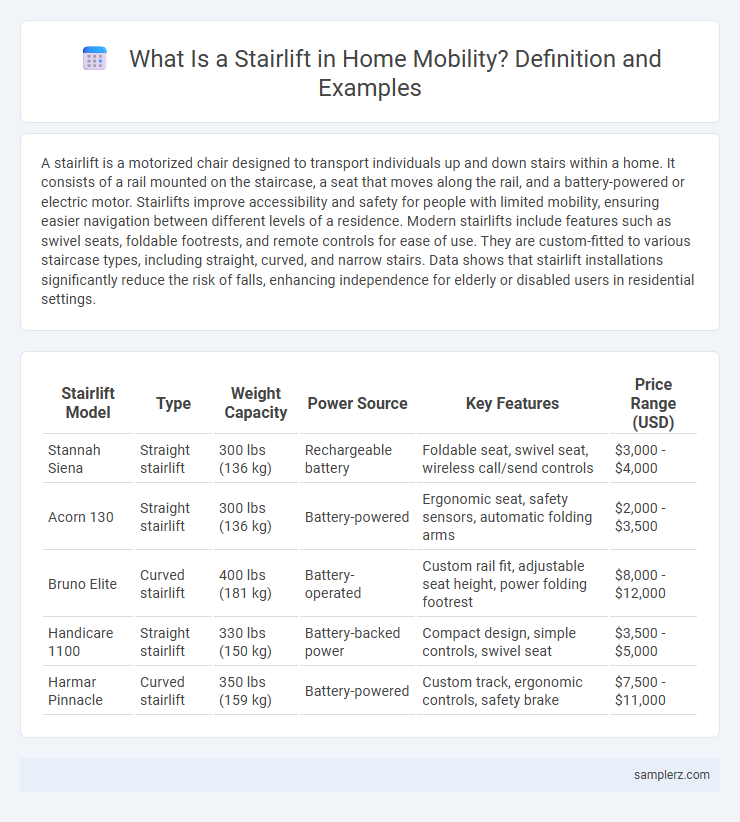A stairlift is a motorized chair designed to transport individuals up and down stairs within a home. It consists of a rail mounted on the staircase, a seat that moves along the rail, and a battery-powered or electric motor. Stairlifts improve accessibility and safety for people with limited mobility, ensuring easier navigation between different levels of a residence. Modern stairlifts include features such as swivel seats, foldable footrests, and remote controls for ease of use. They are custom-fitted to various staircase types, including straight, curved, and narrow stairs. Data shows that stairlift installations significantly reduce the risk of falls, enhancing independence for elderly or disabled users in residential settings.
Table of Comparison
| Stairlift Model | Type | Weight Capacity | Power Source | Key Features | Price Range (USD) |
|---|---|---|---|---|---|
| Stannah Siena | Straight stairlift | 300 lbs (136 kg) | Rechargeable battery | Foldable seat, swivel seat, wireless call/send controls | $3,000 - $4,000 |
| Acorn 130 | Straight stairlift | 300 lbs (136 kg) | Battery-powered | Ergonomic seat, safety sensors, automatic folding arms | $2,000 - $3,500 |
| Bruno Elite | Curved stairlift | 400 lbs (181 kg) | Battery-operated | Custom rail fit, adjustable seat height, power folding footrest | $8,000 - $12,000 |
| Handicare 1100 | Straight stairlift | 330 lbs (150 kg) | Battery-backed power | Compact design, simple controls, swivel seat | $3,500 - $5,000 |
| Harmar Pinnacle | Curved stairlift | 350 lbs (159 kg) | Battery-powered | Custom track, ergonomic controls, safety brake | $7,500 - $11,000 |
Understanding Stairlifts: Enhancing Home Mobility
Stairlifts provide a safe and efficient solution for individuals with limited mobility to navigate stairs within their homes, significantly reducing the risk of falls and increasing independence. Modern stairlifts feature customizable seating, smooth track systems, and user-friendly controls tailored to accommodate various stair configurations and individual needs. Investing in a stairlift enhances home accessibility, ensuring mobility challenges do not compromise daily living activities.
Key Features of Home Stairlifts
Home stairlifts offer key features such as ergonomic seating, smooth and quiet motorized operation, and customizable speed controls to ensure safe and comfortable mobility. Advanced models include swivel seats for easy mounting and dismounting, safety sensors to detect obstacles, and battery backup systems for uninterrupted use during power outages. Compact designs fit various staircase types, including straight, curved, and narrow stairs, enhancing accessibility for individuals with limited mobility.
Types of Stairlifts for Residential Use
Straight stairlifts are designed for homes with a single, uninterrupted staircase, offering a practical and affordable solution. Curved stairlifts accommodate staircases with bends, landings, or intermediate floors, providing customized rail systems for safety and comfort. Outdoor stairlifts are built with weather-resistant materials, ideal for exterior stairs, ensuring durability and reliable mobility in various weather conditions.
Real-Life Examples of Stairlifts in Houses
Stairlifts in homes significantly enhance mobility for individuals with limited strength or balance by providing safe and reliable transportation between floors. Real-life examples show that custom-fitted stairlifts, installed on curved or straight staircases, improve independence and reduce fall risk for seniors and those with disabilities. Features like swivel seats, remote controls, and battery backup systems contribute to user convenience and continuous operation during power outages.
Benefits of Installing a Stairlift at Home
Installing a stairlift at home significantly enhances mobility and independence for individuals with limited mobility or disabilities, reducing the risk of falls on stairs. It provides safe, effortless navigation between floors, allowing users to maintain access to all areas of their home without assistance. Stairlifts also improve quality of life by promoting confidence and enabling users to age in place comfortably and securely.
Choosing the Right Stairlift for Your Home Layout
Selecting the right stairlift for your home layout requires assessing staircase type--straight, curved, or multi-landing--and measuring precise dimensions to ensure a perfect fit. Features like foldable seats, swivel functions, and weight capacity must align with user mobility needs and space constraints. Consulting with certified stairlift providers guarantees customized solutions that enhance safety and accessibility throughout your home.
Stairlift Installation: Step-by-Step Home Example
Stairlift installation begins with a professional assessment to measure the staircase, ensuring precise rail customization for optimal fit and safety. The rail is securely mounted to the stairs, preserving wall integrity and enabling easy navigation around corners or landings. Finally, the stairlift seat and motor are attached, followed by testing key safety features such as speed control and emergency stop mechanisms to guarantee reliable home mobility assistance.
Safety Considerations for Home Stairlifts
Home stairlifts are equipped with essential safety features such as seat belts, obstruction sensors, and swivel seats to prevent falls during use. Proper installation on sturdy, well-maintained staircases ensures stability and reduces the risk of accidents. Regular maintenance and professional inspections further enhance safety by identifying wear or mechanical issues before they cause hazards.
Cost and Maintenance of Home Stairlift Systems
Home stairlift systems typically cost between $2,000 and $5,000, depending on features and installation complexity. Maintenance expenses average around $150 to $300 annually, covering battery replacements, lubrication, and safety inspections. Investing in regular service ensures longevity and optimal performance, reducing long-term repair costs.
User Stories: Improved Independence with Stairlifts
Stairlifts provide enhanced mobility for elderly or disabled individuals, allowing safe and effortless navigation between different floors in a home. Users report increased independence and confidence, reducing reliance on caregivers or family members for daily activities. This improvement in accessibility significantly boosts overall quality of life and in-home autonomy.

example of stairlift in home Infographic
 samplerz.com
samplerz.com